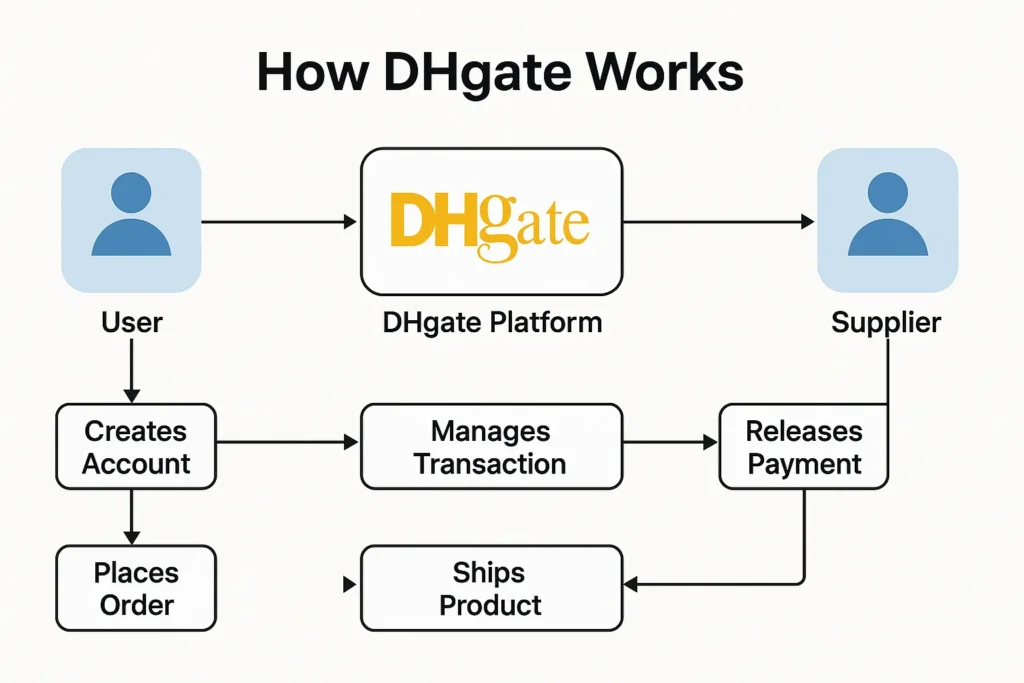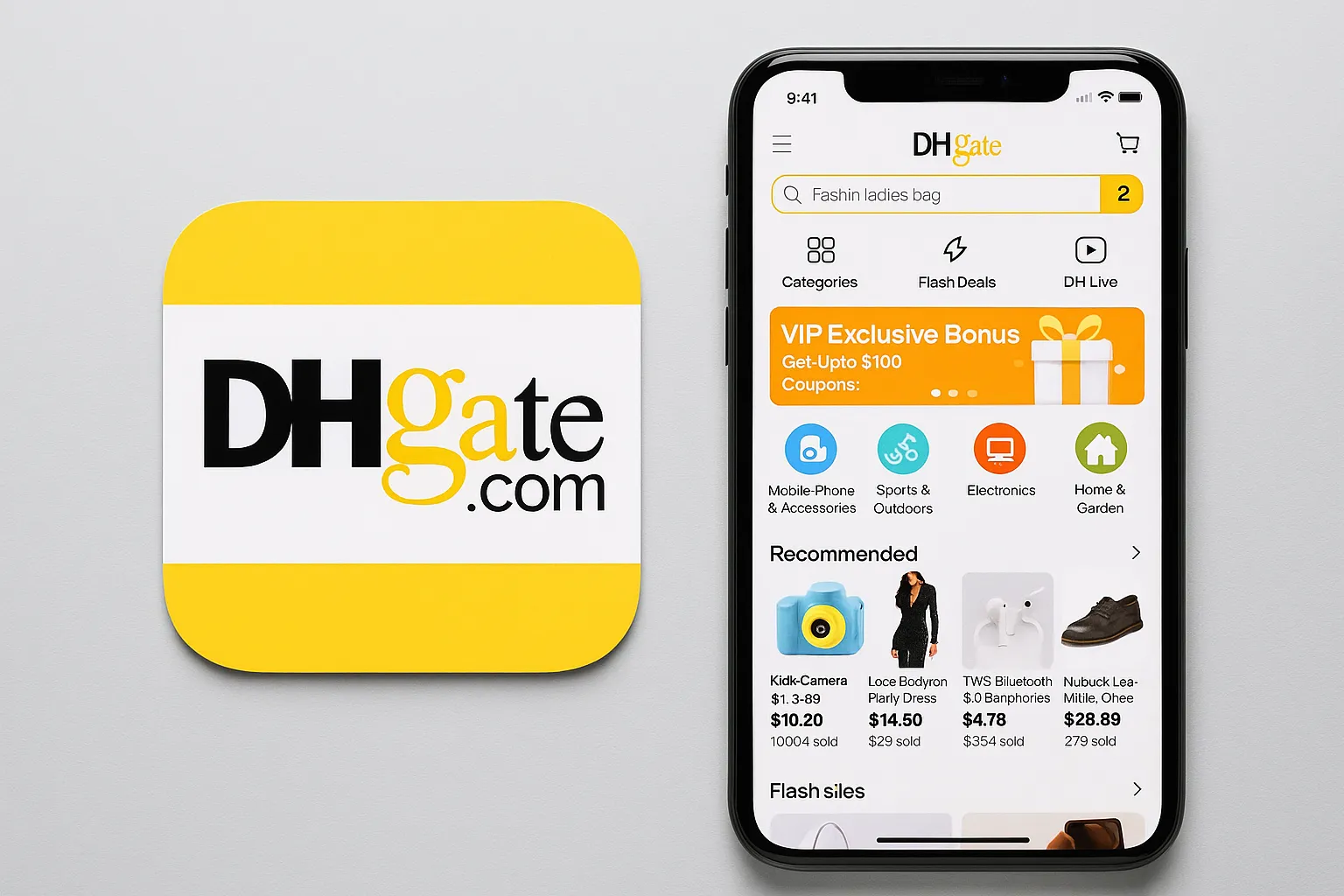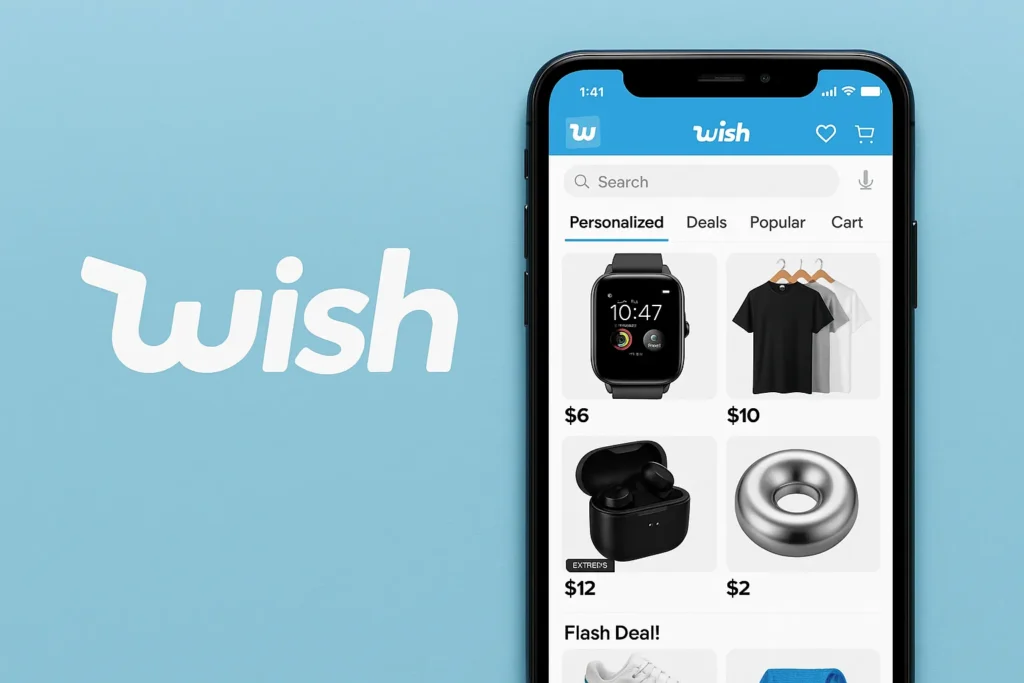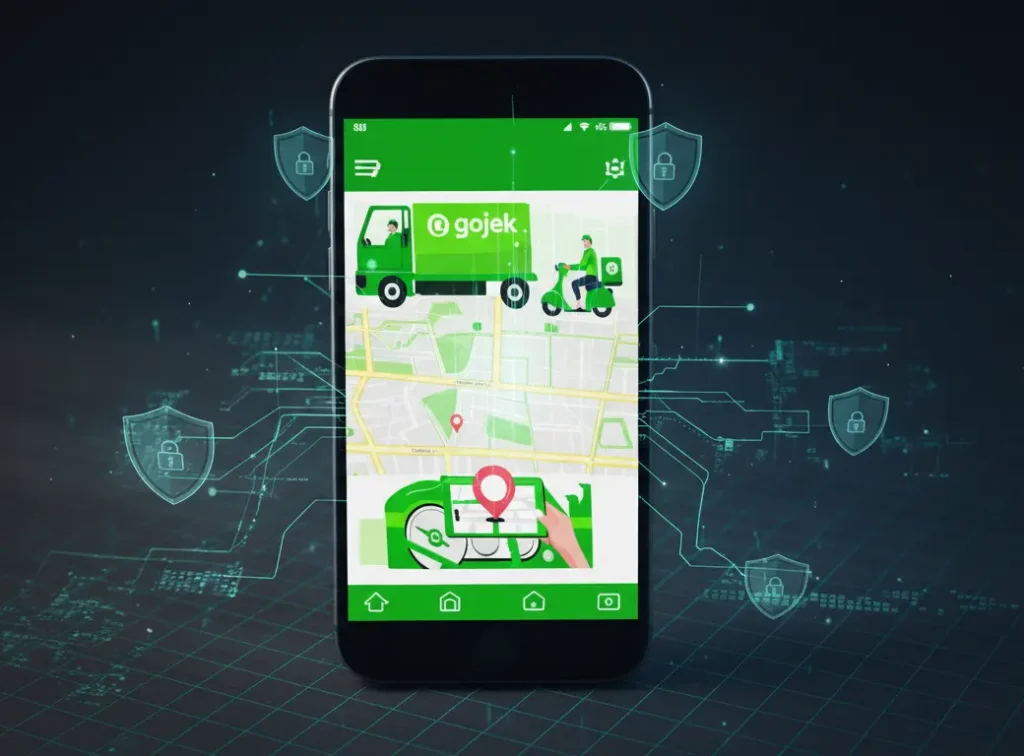Imagine you want to launch a dropshipping store and need 100 affordable products, shipped fast, with a trusted supplier — but you don’t want to fly to China or negotiate with factories.
This is exactly the problem DHgate solves.
Founded in 2004, DHgate has grown into one of the world’s largest cross-border eCommerce marketplaces, connecting millions of global buyers with Chinese manufacturers offering wholesale prices, bulk deals, and increasingly reliable logistics.
Today, in 2025, DHgate serves over 36+ million buyers across 200+ countries, powering small businesses, online sellers, Amazon resellers, and direct consumers looking for budget-friendly Chinese products without complicated sourcing.
What is DHgate? The Simple Explanation
DHgate is a China-based online wholesale marketplace where buyers can purchase products directly from manufacturers and suppliers at low prices. Think of it as a digital bridge between global shoppers and Chinese factories — offering everything from electronics and clothing to accessories, home goods, beauty items, gadgets, and more.
Core Problem It Solves
It eliminates the old, expensive way of sourcing products (traveling to China, meeting suppliers, negotiating deals). DHgate makes wholesale buying simple, safe, and accessible for small businesses worldwide.
Who Uses DHgate? (Target Users)
- Dropshippers
- Amazon, eBay, Walmart sellers
- Small retail stores
- Startup brands sourcing inventory
- Consumers looking for low-cost products
- Resellers buying in bulk for higher profit
- Entrepreneurs testing product-market-fit cheaply
Market Position (2025 Stats)
- 36+ million buyers, 2.3 million sellers
- Ships to 200+ countries
- Over 32 million product listings
- One of the top 3 China wholesale marketplaces globally
- Strong growth in U.S., Europe, Middle East, Africa
Why DHgate Became Successful
- Factory-level pricing without intermediaries
- Wide product selection
- Safe payment system (escrow protection)
- Buyer protection & dispute handling
- Low MOQ (Minimum Order Quantity), ideal for new businesses
- Cross-border shipping solutions improving every year
Read more: How AI and ML Are Powering Next-Gen E-commerce Apps for Maximum Growth
How Does DHgate Work? Step-by-Step Breakdown
DHgate works like a global online marketplace connecting buyers with Chinese suppliers — but with added layers of safety, payment protection, and logistics support. Here’s the simple breakdown:
FOR USERS (BUYERS)
1. Account Creation
- Sign up using email/Google/Apple ID
- Add basic details + shipping address
- Optional: verify identity for larger wholesale orders
2. Browsing & Product Discovery
Buyers can explore:
- Categories (electronics, fashion, beauty, gadgets, etc.)
- Verified sellers
- Bulk deals
- Flash sales
- Dropshipping-friendly suppliers
The platform includes filters like:
- MOQ (minimum order quantity)
- Price range
- Rating
- Shipping options (DHLink, DHL, ePacket, etc.)
3. Placing an Order
A typical buyer journey:
- Search for a product
- Compare suppliers
- Check reviews, ratings, and delivery times
- Add items to cart
- Pay securely (DHgate Escrow holds the money)
- Supplier ships the product
Escrow System:
DHgate only releases money to the seller after the buyer confirms delivery.
4. Receiving Delivery
- Standard delivery (10–25 days)
- Express (3–7 days depending on supplier)
- Tracking provided through DHgate
5. Buyer Protection
If anything goes wrong:
- Product not received
- Damaged
- Wrong item
- Fake item
- Not as described
Buyers can open a dispute, and DHgate intervenes.
FOR SELLERS (SUPPLIERS)
1. Onboarding Process
- Register a seller account
- Upload business documents
- Add product listings
- Set MOQ, pricing, variants, shipping methods
2. How They Operate
Suppliers receive orders → prepare inventory → ship to buyers using DHgate-supported logistics or third-party carriers.
3. Earnings & Commission Structure (2025)
DHgate charges sellers:
- 0%–8% commission based on product category
- Transaction fees (small percentage)
- Optional paid ads/promotions inside DHgate
Suppliers earn the remaining amount after DHgate releases funds post-delivery confirmation.
TECHNICAL OVERVIEW (Simplified)
DHgate runs on a modern eCommerce architecture:
Frontend
- Mobile apps (iOS/Android)
- Web platform
- Real-time search, filters, recommendations
Backend
- Marketplace engine to match buyers & sellers
- Order management system (OMS)
- Payment escrow system
- Supplier inventory management
- Review/rating system
Key Technologies Used
- Cloud infrastructure (China-based & global CDNs)
- AI-based fraud detection
- Recommendation engine for product discovery
- Secure payment gateway
- Logistics integration (DHLink, DHL, UPS, ePacket API)

DHgate’s Business Model Explained (2025)
DHgate follows a multi-revenue marketplace model, earning money from sellers, transactions, promotions, and logistics partnerships. Here’s the full breakdown:
1. How DHgate Makes Money
✔ Commission Fees (Primary Revenue)
DHgate charges suppliers 0%–8% commission depending on product category.
Higher-risk or high-demand categories have higher fees.
✔ Transaction Fees
A small percentage is charged on every order to cover:
- Payment processing
- Escrow service
- Fraud prevention systems
✔ Advertising & Sponsored Listings
Sellers pay to:
- Boost product ranking
- Promote items in category pages
- Run banner ads
- Appear in “Top Picks” or “Hot Deals”
Similar to Amazon ads or Alibaba PPC.
✔ Membership & Value-Added Services
Some suppliers upgrade for:
- Lower commission
- Better visibility
- Access to premium analytics
- Dedicated account managers
✔ Logistics & Shipping (DHLink)
DHgate earns commissions from:
- DHLink shipping service
- Carrier partnerships (DHL, UPS, FedEx, ePacket)
✔ Currency Exchange Margins
DHgate earns small margins when converting international payments.
2. Pricing Structure (2025)
For buyers:
- Most products follow factory-direct pricing
- Bulk purchase discounts
- Flash sales & seasonal offers
For sellers:
- Commission: 0–8%
- Ad costs: flexible (CPC/CPM)
- Premium seller services: subscription-based
3. Market Size & Growth (2025)
- Global cross-border eCommerce in 2025: $6.2 trillion
- China dominates with 35%+ market share
- DHgate handles hundreds of millions of transactions yearly
- Strongest markets: U.S., Europe, Middle East, Africa
4. Profit Margins Insights
DHgate’s model is highly scalable because:
- No inventory cost
- No warehouses
- No manufacturing expenses
- Low operational overhead
Most revenue comes from recurring seller commissions + advertisements.
DHgate Revenue Model Breakdown
| Revenue Source | Description | % Contribution (Approx.) |
| Commission Fees | Fees from seller sales | 45% |
| Transaction Fees | Escrow + payment processing | 20% |
| Advertising (PPC/Boosts) | Sponsored listings, promotions | 25% |
| Logistics Partnerships | DHLink, carrier commissions | 7% |
| Premium Seller Services | Membership & analytics | 3% |
Key Features That Make DHgate Successful
DHgate didn’t become a global wholesale giant by accident — its success is built on a combination of technology, pricing strategy, buyer protection, and supplier diversity. Here are the features that make DHgate stand out in 2025.
Top 10 Features of DHgate (With Benefits + Why They Matter)
1. Massive Product Catalog (32M+ Items)
Why it matters: Buyers can find almost any product category.
Benefit: Ideal for dropshippers & resellers testing multiple niches.
Innovation: Smart search + AI product categorization.
2. Factory-Direct Pricing
Why it matters: Eliminates middlemen.
Benefit: Lowest global prices for bulk or single orders.
Innovation: Automated MOQ tools & supplier pricing analytics.
3. DHgate Escrow Payment Protection
Why it matters: Boosts buyer confidence.
Benefit: Money isn’t released until the buyer confirms delivery.
Innovation: Multi-layer fraud detection & automated dispute resolution.
4. Verified Suppliers Program
Why it matters: Reduces risk for businesses.
Benefit: Buyers get trusted manufacturers with quality assurance.
Innovation: Supplier performance scoring system (2025 update).
5. DHLink Global Logistics
Why it matters: Faster & more predictable shipping.
Benefit: Delivery reliability improved by 40% in 2025.
Innovation: Direct integration with DHL, UPS, FedEx, ePacket APIs.
6. Low Minimum Order Quantity (MOQ)
Why it matters: Perfect for new entrepreneurs.
Benefit: You can test products without bulk investment.
Innovation: Supplier-side real-time MOQ adjustments.
7. Advanced Filtering & Search
Why it matters: Saves buyers hours of research.
Benefit: Users can filter by MOQ, price, seller rating, shipping time, etc.
Innovation: AI-powered personalized recommendations.
8. Secure Messaging & Negotiation System
Why it matters: Enables real-time communication.
Benefit: Negotiate custom pricing or product specs easily.
Innovation: Translation layer for cross-language communication.
9. Product Videos & Live Streaming (2025 Update)
Why it matters: Buyers can view the product live.
Benefit: Lower return rates + better trust.
Innovation: Mobile live-streaming interface for suppliers.
10. Mobile App With Real-Time Tracking
Why it matters: 70% of DHgate buyers use mobile.
Benefit: Track orders, chat with sellers, join flash sales instantly.
Innovation: Push notifications + AI tracking prediction.
2025 Recent Feature Updates
- AI-based Smart Supplier Matching (helps buyers find the best factory for their niche)
- Live commerce for wholesale
- One-click dropshipping integration
- Enhanced dispute resolution chatbot
- Better anti-counterfeit verification tools
AI/ML Integrations Inside DHgate
- Product recommendations
- Fraud risk scoring
- Supplier trust scoring
- Fake product detection
- Price optimization insights
What Sets DHgate Apart
- Low starting investment (low MOQ)
- Massive global trust base
- Strong buyer protection system
- Cross-border logistics network
- Better small-business support than competitors

The Technology Behind DHgate
DHgate operates at massive scale — millions of products, millions of users, 200+ countries, and thousands of orders happening every hour. To support this, it uses a modern, scalable tech stack designed for speed, security, and cross-border commerce.
Here’s the complete, simplified technical breakdown.
1. Tech Stack Overview (Simplified for 2025)
Frontend (User Interface)
- React + Vue.js (for web interface)
- Swift (iOS)
- Kotlin/Java (Android)
- Responsive, high-speed UI optimized for global users
- Real-time search + catalog filtering
Backend (Marketplace Engine)
- Java & Node.js microservices
- Python for AI/ML modules
- Modular service-based architecture
- APIs for:
- Payments
- Orders
- Reviews
- Messaging
- Logistics
- Supplier dashboard
Database & Storage
- MySQL / MariaDB (structured data)
- MongoDB / Cassandra (product catalogs & big data)
- ElasticSearch (search + filters + recommendations)
- Alibaba Cloud OSS (image/video storage)
AI & Machine Learning Modules
- Fraud detection
- Seller scoring
- Product recommendations
- Image recognition to detect counterfeit items
- Price optimization
2. Real-Time Capabilities Explained
DHgate uses event-driven systems to handle:
- Real-time inventory updates
- Live chat messaging
- Live video streaming
- Flash sale countdowns
- Real-time logistics tracking
This ensures the platform can handle peak events, sometimes over 5–10 million concurrent users.
3. Data Handling & Privacy
DHgate follows:
- PCI DSS for payment security
- GDPR-style privacy compliance for international buyers
- AI-based fraud prevention
- Encrypted transactions & escrow security
User data such as address, order history, and payment info stays protected under encrypted systems.
4. Scalability Approach
DHgate uses:
- Cloud autoscaling
- CDN acceleration for fast loading worldwide
- Microservices, allowing independent scaling of:
- Order engine
- Messaging
- Search engine
- Payments
- Logistics APIs
This keeps the platform stable even during big global sales (Singles’ Day, Black Friday).
5. Mobile App vs Web Platform
Mobile App
- Faster and personalized
- Push notifications
- Live streams
- Better product discovery
- Integrated secure wallet payments
Web Platform
- Best for B2B bulk buyers
- Advanced supplier dashboards
- Large catalog browsing
Both sync in real time using cloud-based APIs.
6. API Integrations
DHgate uses third-party APIs for:
- Payments: Visa, Mastercard, PayPal, local wallets
- Logistics: DHL, UPS, FedEx, ePacket, Cainiao
- Translations: AI-supported multilingual chat
- Currency conversion: real-time FX APIs
These integrations help DHgate operate globally with minimal friction.
7. Why This Tech Matters for the Business
- Ensures global accessibility
- Supports millions of products without lag
- Protects buyers from fraud
- Gives sellers a powerful dashboard
- Keeps operations affordable & scalable
- Powers AI-driven recommendations, increasing sales
DHgate’s Impact & Market Opportunity
DHgate has transformed global eCommerce by making Chinese wholesale sourcing accessible to anyone — from small online sellers to large retail chains. Its impact extends across multiple industries and continues to grow in 2025.
1. Industry Disruption Caused by DHgate
✔ Democratized Access to Chinese Manufacturing
Before DHgate, sourcing from China required:
- Traveling overseas
- Meeting factories in person
- Bulk order commitments
DHgate changed the rules by allowing:
- Small orders
- Instant supplier communication
- Factory-direct pricing
This empowered millions of small businesses worldwide.
✔ Boost to Dropshipping & Reselling Industries
DHgate helped fuel:
- Shopify dropshipping boom
- Amazon FBA product sourcing
- Instagram/Facebook store sellers
- Local retail resellers
Its low MOQs and affordable products make it ideal for testing new business ideas.
✔ Direct Competition to Alibaba, AliExpress & Global B2B Platforms
DHgate carved out its own niche:
- Stronger buyer protection
- More small-scale wholesale options
- Better pricing for specific categories (fashion, gadgets, accessories)
2. Market Statistics & Growth (2025)
- Global cross-border eCommerce (2025): $6.2 trillion
- China’s share: 35%+
- DHgate buyers: 36 million+
- Active suppliers: 2.3 million+
- Products listed: 32 million+
- Fastest-growing regions:
- Middle East (+28% YoY)
- Africa (+32% YoY)
- Latin America (+20% YoY)
DHgate continues to be one of the top 3 China-based wholesale platforms worldwide.
3. User Demographics & Buying Behavior
Buyers are mostly:
- Entrepreneurs aged 20–45
- Online store owners
- Amazon/eBay/Walmart sellers
- Small retail shop owners
- Side hustlers
Top Categories Purchased:
- Electronics accessories
- Fashion items
- Beauty & personal care
- Gadgets
- Home & kitchen
- Jewelry & watches
4. Geographic Presence
DHgate ships to 200+ countries, with major markets in:
- United States
- United Kingdom
- Canada
- Australia
- UAE & Saudi Arabia
- South Africa
- Mexico & Brazil
Its combination of low prices + global logistics makes it highly competitive.
5. Future Projections (2025–2030)
Analysts predict:
- DHgate’s GMV could grow 12–18% annually
- Wider AI integration across search, fraud control, and supplier ranking
- Expansion of DHLink logistics into same-week delivery in Europe & Middle East
- More live-commerce driven wholesale transactions
- Growth of private-label manufacturing partnerships
6. Opportunities for Entrepreneurs
DHgate’s success shows massive demand for:
- Wholesale marketplaces
- Cross-border eCommerce platforms
- Dropshipping ecosystems
- B2B marketplaces
- Niche wholesale directories
This opens opportunities for founders who want to build:
- A niche marketplace (fashion, beauty, gadgets, etc.)
- A regional wholesale platform
- A B2B marketplace serving specific industries
- A DHgate-style cross-border platform
Natural Transition
This massive success is why many entrepreneurs want to create similar wholesale and B2B marketplace platforms — and they look for ready-made solutions that reduce cost and time.
Building Your Own DHgate-Like Platform
Creating a platform like DHgate is one of the most lucrative business opportunities in 2025. With global cross-border eCommerce booming and buyers increasingly trusting online wholesale sourcing, entrepreneurs are actively launching B2B + B2C marketplace platforms inspired by DHgate’s model.
Below is the complete guide.
1. Why Businesses Want DHgate-Style Marketplaces
✔ Huge Market Size
Cross-border eCommerce is a $6.2 trillion space — and wholesale marketplaces dominate a major share.
✔ Low Competition (Outside China)
Most DHgate competitors are China-based.
Countries like the U.S., India, UAE, Saudi Arabia, Europe, Africa, and SEA have massive gaps in:
- Local wholesale apps
- Niche B2B marketplaces
- Import-export platforms
✔ High Supplier Demand
Manufacturers want:
- Global visibility
- Direct orders
- Verified buyers
- A platform to showcase catalogs
This makes onboarding easier.
✔ Scalable & High-Margin Model
Marketplace owners don’t handle:
- Inventory
- Warehousing
- Manufacturing
You earn through:
- Commissions
- Ads
- Premium seller plans
- Logistics partnerships
2. Key Considerations Before Development
To build a successful DHgate-like platform, plan for:
✔ Supplier-side onboarding system
Easy registration → product listing → analytics dashboard.
✔ Buyer protection
Escrow-style secure payment system.
✔ Logistics integrations
APIs with DHL, UPS, FedEx, local couriers, etc.
✔ Real-time search engine
Millions of SKUs must load instantly.
✔ Scalable architecture
Marketplace traffic spikes heavily during seasonal sales.
✔ Fraud prevention & trust scoring
Essential for cross-border orders.
3. Time & Cost Factors (2025)
Development Time Without Ready Scripts
- 8–12 months (custom build)
- Expensive: $60,000 – $300,000+
Using Miracuves Clone Solutions
- Go Live in 3-6 Days
- Cost starts from $2,499 – $3,299 (depending on customization)
- Includes:
- Buyer/Seller apps
- Admin panel
- Escrow system
- Logistics API integration
- Multi-currency
- Real-time chat
- Rating/review system
- Product catalog module
Perfect for entrepreneurs who want to enter the market fast.
4. Essential Features Your DHgate-Like Platform Must Include
- Multi-vendor catalog
- Secure escrow payments
- Supplier onboarding
- Buyer protection
- Bulk pricing + MOQ options
- Logistics/shipping integration
- Product variations & attributes
- Real-time chat/negotiation
- Review & rating system
- AI product recommendations
- Multi-language & currency support
- Supplier verification process
Read more: Breaking Down the Cost of Developing an eCommerce Platform in 2025
Conclusion
DHgate has become one of the world’s most influential cross-border wholesale marketplaces — empowering millions of entrepreneurs, resellers, and small businesses with factory-direct access to affordable products. Its success comes from a powerful mix of technology, trust, supplier diversity, and a platform model that removes traditional barriers to global sourcing.
By offering low MOQs, secure escrow payments, strong buyer protection, and seamless global logistics, DHgate continues to dominate the B2B eCommerce space in 2025. The platform not only connects buyers and suppliers but also fuels entire industries such as dropshipping, Amazon FBA, private labeling, and local retail.
As wholesale demand grows worldwide, the market is wide open for entrepreneurs who want to build their own DHgate-style marketplace. Whether it’s a niche B2B platform or a full-scale global wholesale app, the opportunity is massive.
And with Miracuves’ proven, customizable, and fast-to-launch marketplace solutions, you can build a DHgate-like platform in just 3-6 days — complete with modern features, scalable architecture, and enterprise-level security.
Ready to build your own DHgate-like marketplace? Contact us today and get a free consultation with our experts
FAQs
Q:1 How does DHgate make money?
DHgate makes money through seller commissions (0–8%), transaction fees, advertising placements, premium seller services, and logistics partnerships.
Q:2 Is DHgate available in my country?
Yes. DHgate ships to 200+ countries, including the U.S., UK, Europe, Middle East, Africa, and Asia.
Q:3 How much does DHgate charge users?
Buyers usually pay only the product cost + shipping. DHgate does not charge buyers extra platform fees in most categories.
Q:4 What’s the commission for DHgate suppliers?
DHgate charges suppliers 0%–8% commission, depending on the product category.
Q:5 How does DHgate ensure safety for buyers?
DHgate uses Escrow Payment Protection, buyer-seller dispute management, fraud detection AI, verified supplier programs, and secure encrypted transactions.
Q:6 Can I build something similar to DHgate?
Yes. You can build a DHgate-like wholesale marketplace using a ready-made Miracuves clone solution — customizable, scalable, and launch-ready in 3-6 days.
Q:7 What makes DHgate different from competitors?
DHgate stands out by offering factory-direct pricing, low MOQs, strong buyer protection, and a massive global supplier network ideal for small businesses and resellers
Q:8 How many users does DHgate have?
As of 2025, DHgate has 36+ million global buyers and 2.3+ million suppliers.
Q:9 What technology does DHgate use?
DHgate uses a microservices architecture powered by Java, Node.js, Python, React/Vue, MySQL, MongoDB, AI fraud detection, and global CDN acceleration.
Q:10 How can I create an app like DHgate?
You can create a DHgate-like platform using Miracuves’ wholesale marketplace clone script, which includes buyer/seller apps, escrow payments, logistics APIs, and can launch in 3-6 days.
Related Articles:







